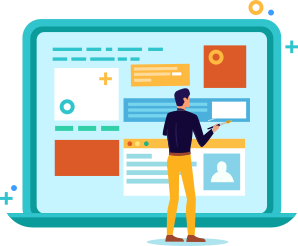UI Design
The user interface is the pictures, shapes, and colors mounted on the UX design that make the platform appealing to the user. Unlike UX the designer has more freedom while designing the UI when it comes to following the rules and can design more flexibly and more creatively. After the design is done it is handed to the programmers and developers. One of the common mistakes in this market is to assign graphical designers to design the UI of a platform. Graphic design includes designing posters, billboards, or catalogs which are all 2D designs. But while designing the UI, the designer must know colors, understand how to use tools, know the rules of UI design, and how to make it user-friendly. Understanding the importance of dimensions while designing borders or shadows and such is also very important, as well as knowing how to use CSS effects or the existing libraries, and how to code in CSS or HTML.
Google has set up rules and frameworks in different parts of the web to optimize the relationship between a platform and the user and these rules apply to UI design as well. Following these rules such as font or button size can be hard for designers forcing them to change their design. This is where the skill of the designer shows its importance. The designer can choose to have a layered design, or a one-page design, or an interactive, bold, and optimized design for the platform. This phase is the last part where any visual innovation can be used because it must be presented to the employer as an interactive file to gain their approval. Ashid determines the final version with the help of the employer and afterward, the programmers start to build the platform keeping all the details in the design.


Please write your opinion about this article